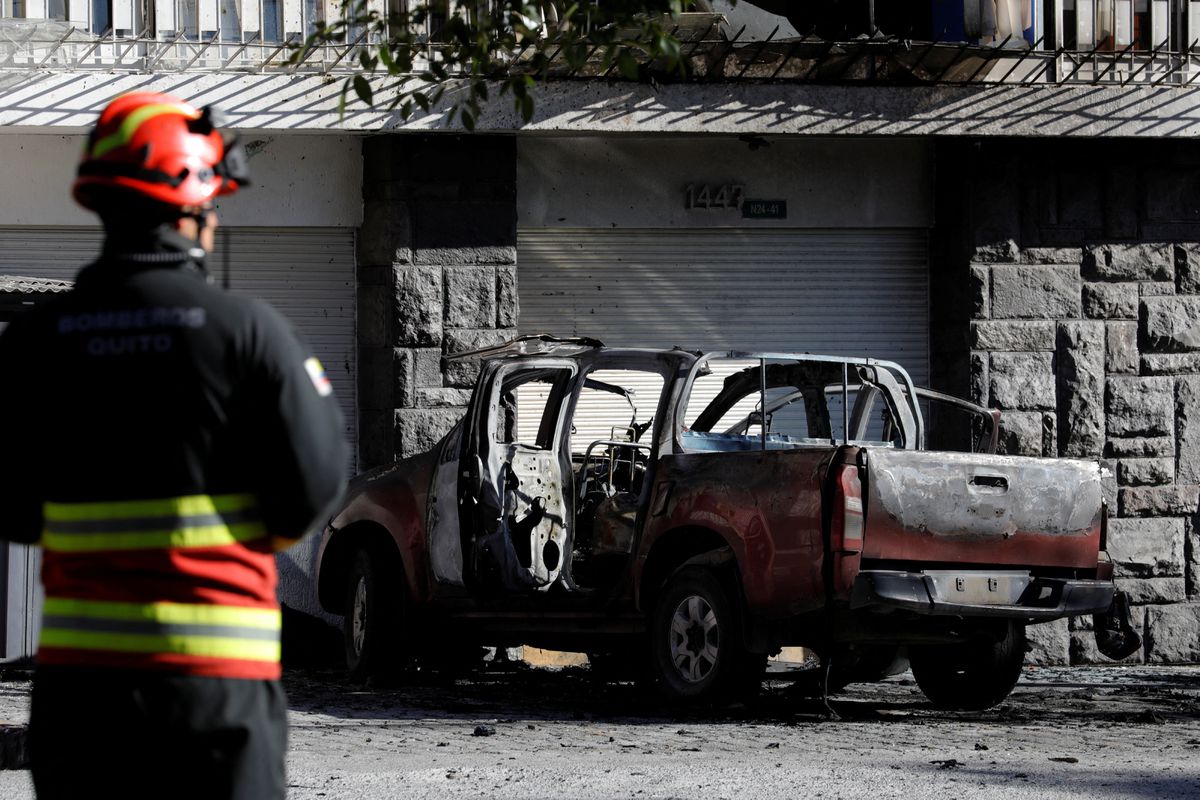
Four car bombs exploded in Ecuador overnight within hours of each other without injuring anyone, police said Thursday, but they served to underscore the South American country’s fragile security. Ecuador’s National Police said two of the bombs exploded in Quito, the capital, while the other two went off in a province that borders Peru. The explosions happened three weeks after the assassination of a presidential candidate rattled Ecuadorians.
Ecuador National Police Gen. Pablo Ramírez, the national director of anti-drug investigations, told reporters Thursday the explosions in Quito were related to “several transfers of inmates” that took place this week. But police did not immediately offer a possible motive for the explosions in the southern province of El Oro.
In Quito, the first bomb went off Wednesday night in an area of the city where an office of the country’s corrections system was previously located, while the second bomb exploded outside the agency’s current location.
The corrections system, known as the National Service for Attention to Persons Deprived of Liberty, in recent years lost control of large prisons, which have been the site of violent riots resulting in dozens of deaths, and has taken to transfer inmates to manage gang-related disputes.
Ramírez said police found gas cylinders, fuel, fuses and blocks of dynamite among the debris of the crime scenes in Quito, where the first vehicle to explode was a small car and the second was a pickup truck.
Authorities said gas tanks were used in the explosions in the El Oro communities of Casacay and Bella India.
The mayor of Quito, Pabel Muñoz, told the Teleamazonas television station that he was hoping “for justice to act quickly, honestly and forcefully.”
“We are not going to give up. May peace, calm and security prevail among the citizens,” Muñoz said.
Ecuadorian authorities attribute the country’s spike in violence over the past three years to a power vacuum triggered by the killing in 2020 of Jorge Zambrano, alias “Rasquiña” or “JL,” the leader of the local Los Choneros gang. Members carry out contract killings, run extortion operations, move and sell drugs, and rule prisons.
Los Choneros and similar groups linked to Mexican and Colombian cartels are fighting over drug-trafficking routes and control over territory, including within detention facilities, where at least 400 inmates have died since 2021.
Presidential candidate Fernando Villavicencio, who had a famously tough stance on organized crime and corruption, was killed Aug. 9 at the end of a political rally in Quito despite having a security detail that included police and bodyguards.
He had accused Los Choneros and its imprisoned current leader Adolfo Macías, alias “Fito,” whom he linked to Mexico’s Sinaloa Cartel, of threatening him and his campaign team days before the assassination.
Ecuador’s Security Secretary, Wagner Bravo, told FMundo radio station that six prisoners who were relocated may have been involved in Villavicencio’s slaying.
Bravo also revealed that inmates in a prison in the southern part of the country kidnapped a group of police and corrections officers Wednesday.
In a video shared on social media, which Interior Minister Juan Zapata identified as authentic, a police officer who identifies himself as Lt. Alonso Quintana asks authorities “not to make decisions that violate the rights of persons deprived of their liberty.” He can be seen surrounded by a group of police and corrections officers and says that about 30 people are being held by the inmates.
The country’s National Police tallied 3,568 violent deaths in the first six months of this year, far more than the 2,042 reported during the same period in 2022. That year ended with 4,600 violent deaths, the country’s highest in history and double the total in 2021.
The port city of Guayaquil has been the epicenter of violence, but Esmeraldas, a Pacific coastal city, is also considered one of the country’s most dangerous. There, six government vehicles were set on fire earlier this week, according to authorities.
Sign up for our weekly newsletter to get more English-language news coverage from EL PAÍS USA Edition
This post was originally published on this site be sure to check out more of their content.







